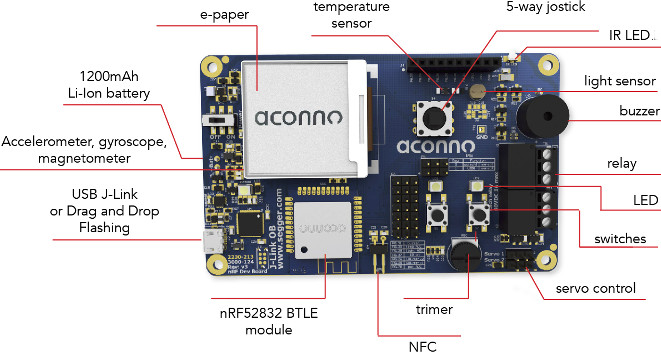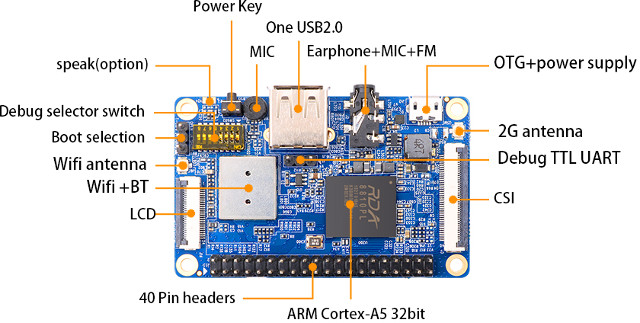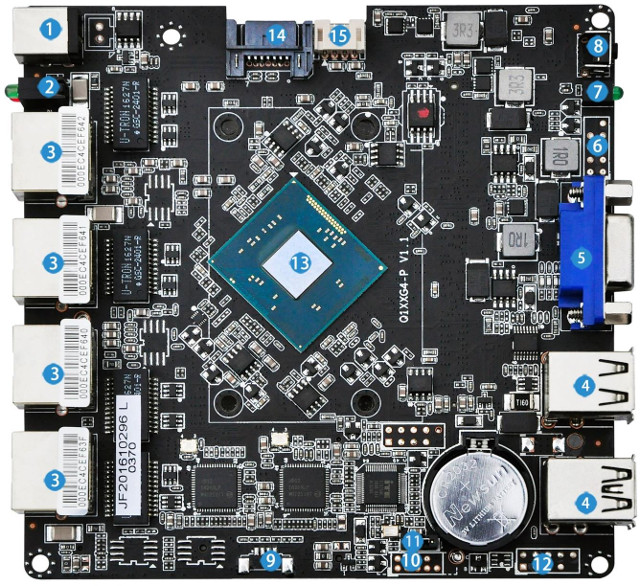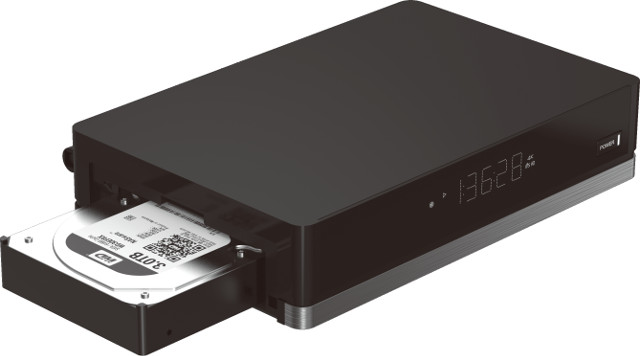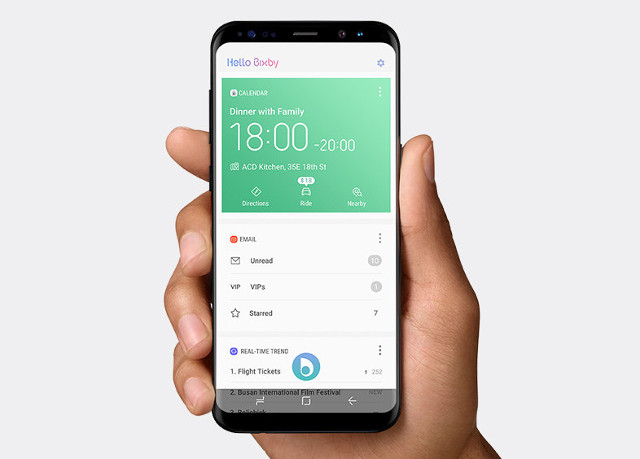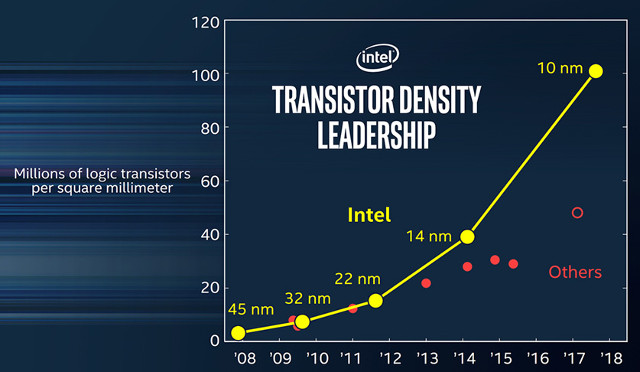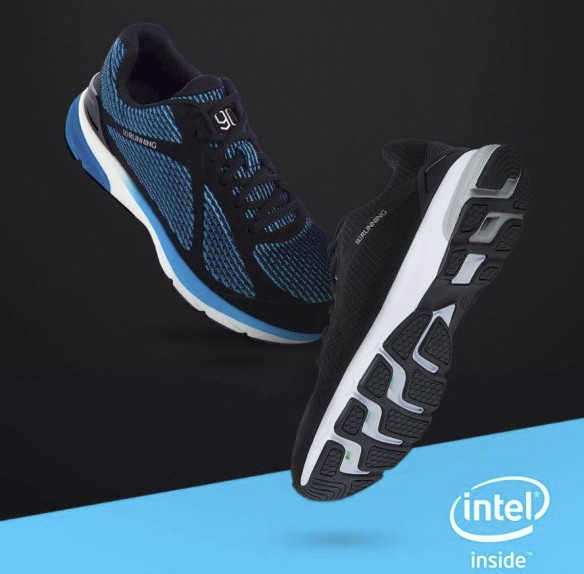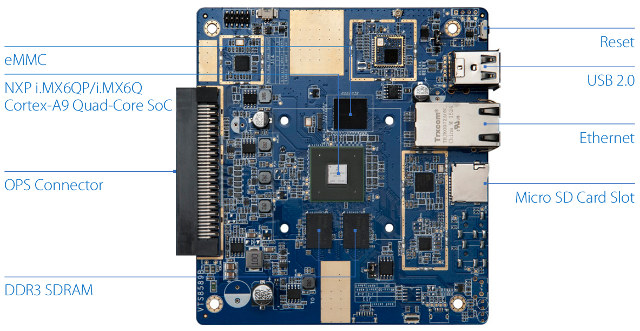Bluetooth 5 is the latest iteration of Bluetooth with up to four times the speed and twice the range of Bluetooth 4.0 LE, and so far apart from Puck.js and Nordic Semi nRF52840 devkit, I had not seen many Bluetooth 5 IoT modules or boards. Aconno, a German startup, has designed ACD-52832 Bluetooth 4.0 / Thread / ANT+ IoT development board based on their own nRF52832 module, and equipped with some goodies like a black & white e-Paper display, a joystick, sensors, I/Os, etc… They’ve also launched an updated module with Bluetooth 5 using nFR52840 SoC. I don’t have the full details about the new module, but the nRF52832 module and devkit is interesting to look at, especially features should be similar. Aconno ACD-52832 board specifications: Wireless Module – ACN52832 based on Nordic Semi nRF52832 ARM Cortex-M4 @ 64 MHz SoC with Bluetooth Smart, ANT+, Thread, NFC, and 2.4 GHz […]
Orange Pi 2G-IoT ARM Linux Development Board with 2G/GSM Support is Up for Sale for $9.90
Orange Pi 2G-IoT was unveiled at the start of the year as an ultra cheap ($10) Linux development board with 2G cellular connectivity. The board has just launched for $9.90 + shipping on Aliexpress. Orange Pi 2G-IoT specifications have changed a little since the initial announced as WiFi is confirmed to be supported: SoC – RDA Micro 8810PL ARM Cortex A5 processor @ up to 1.0 GHz with 2Gbit (256 MB) on-chip LPDDR2 RAM, 4Gbit (512 MB) on-chip SLC NAND flash , 256KB L2 cache, Vivante GC860 3D GPU, and GSM/GPRS/EDGE Modem (Download datasheet) External Storage – micro SD slot Display I/F – LCD connector up to qHD resolution Video – Decoding up to 1080p30, encoding up to 1080p30 H.264 Audio I/F – 3.5mm audio +FM jack, built-in microphone? Connectivity – WiFi 802.11 b/g/n + Bluetooth 2.1/EDR module (RDA5991), and 2G GSM/GPRS/EDGE module with SIM card slot Camera – MIPI […]
$100 Qotom Q1900G4-M Nano-ITX Board Powered by Intel Celeron J1900 SoC is Equipped with Four Gigabit Ethernet Ports
Qotom Q1900G4-M is a motherboard designed for networking applications thanks to four Gigabit Ethernet ports connected to an Intel Celeron J1900 quad core “Bay Trail” processor. The board supports up to 8GB DDR3 RAM via a SO-DIMM slot, storage through a SATA port and an mSATA connector, and WiFi or cellular connectivity through a mini PCIe slot and SIM card slot. Qotom Q1900G4-M board specifications: SoC – Intel Celeron J1900 quad core “Bay Trail” processor @ 2.0 GHz / 2.41 GHz (Burst) with Intel HD graphics (10W TDP) System Memory – 1x SO-DIMM sockets for up to 8GB DDR3 memory Storage – 1x SATA 3.0 port + power (14 & 15), 1x mini PCIe connector for mSATA SSD (16) Video Output – VGA (5) Connectivity 4x Gigabit Ethernet ports (3) with Wake-on-LAN support SIM card socket (17) USB only mini PCIe connector for WiFi, 3G or 4G (18) USB – 3x […]
MeLE V9 4K Android TV Box Comes with a 3.5″ SATA Slot, a Cooling Fan
We’ve seen several devices based on Realtek RTD1295 processor. They all come with a SATA interface, either via an external connector like Zidoo X9S, a 2.5″ SATA bay like Beelink SEA I, or a 3.5″ SATA bay as found in Eweat R9 Plus. However, all those devices are fanless, and at least one person expressed concerns when using a device with an internal hard drive without active cooling. MeLE V9 fills that gap, as the RTD1295 TV box features a 3.5″ SATA slot and an active fan for cooling both the device and the hard drive. MeLE V9 specifications: SoC – Realtek RTD1295 quad core Cortex A53 processor with ARM Mali-T820 MP3 GPU System Memory – 2GB DDR3 Storage – 16GB eMMC flash + 3.5″ SATA slot + SD/SDXC card slot Video I/O – HDMI 2.0a output up to 4K @ 60 Hz with 10-bit HDR support, AV port, and […]
Samsung Galaxy S8 & S8+ Smartphones Launched with Infinity Screen, Samsung DeX Desktop Mode, Bixby Assistant
Samsung has finally launched their latest Galaxy S8 and S8+ smartphones powered by Qualcomm Snapdragon 835 or Exynos 8895 processor, 5.8″ and 6.2″ screens , and some of the most interesting features include the “infinity screen” with ultra thin bezels, Samsung DeX allowing for a desktop experience on a large monitor when the phone is docked, as well as Bixby assistant. Samsung Galaxy S8/S8+ specifications: SoC (one or the other depending on markets) Qualcomm Snapdragon 835 octa-core processor with four Kryo 280 cores @ 2.3 GHz, four Kryo 280 cores @ 1.7 Ghz;; Adreno 540 GPU; 10nm process Samsung Exynos 8895 octa-core processor with four M2+ cores @ 2.35 GHz, four Cortex A53 cores @ 1.9 GHz, ARM Mali-G71 GPU; 10nm process System Memory – 4GB LPDDR4 Storage – 64GB UFS 2.0 flash; micro SD up to 256 GB Display Galaxy S8 – 5.8” quad HD+ (2960×1440), (570ppi) Galaxy S8+ […]
Intel: My 10nm Process is Denser Than Yours
Process technology is important as the lower the process node, the more efficient the processor becomes, which leads to either longer battery life for the same tasks on battery powered devices, or allows for higher frequencies extracting more performance. Qualcomm and Samsung recently announced Snapdragon 835 SoC was manufactured using 10nm process technology, but Mark Bohr, an Intel Senior Fellow and director of process architecture and integration at Intel Corporation. wrote a blog post explaining that while in the past process node size and density were progressing in a “linear” fashion, this is not the case anymore, as marketing has changed, and some companies advance node names, even in cases where there’s minimal or no density increase. The chart above implies that some companies 10nm process is barely better than Intel’s 14 nm process, with their 10nm process capable of integrating about twice as much transistors per square millimeter compare […]
$100 Xiaomi “90 Minutes Ultra Smart Running Shoes” are Equipped with Intel Curie Module
If you’ve ever used a fitness tracker on a wristband, you must know that although it gives an indication of your level of activity, it’s usually not really accurate to count steps. Xiaomi’s “90 Minutes ultra smart running shoes” fixes the issue as the fitness tracker powered by Intel Curie module is placed right inside the shoes. Most of the information is in Chinese, and I could only find limited specifications for the shoes: Size – 39 to 45 Intel Curie Module based on Quark SE SoC with 6-axis accelerometer and gyroscope, Bluetooth 4.0 LE connectivity Battery – Good for 60 days on a charge Material Shoe sole – Rubber Shoe vamp – Fabric + Synthetic leather Shoe insole – Antibacterial removable air cushions The small device based on Intel Curie module resides inside the sole, stores fitness data such steps, distance covered, speed, (estimated) calories burnt, etc… It’s unclear […]
VIA VTS-8589 OPS Board Powered by NXP i.MX 6 ARM Processor Complies with Intel’s OPS Digital Signage Specifications
Intel introduced the Open Pluggable Specifications (OPS) defining mechanical and electrical requirements for boards used in digital signage back in 2010. Since then there has been a few Intel OPS boards launched on the market, and the company introduced OPS+ specifications with support for simultaneous display and broadcast usages, 8K resolution displays, and the ability to drive three individual 4K resolution display outputs. VIA has now launched VTS-8589 OPS board compliant with the older specifications, and featuring NXP i.MX6 quad core ARM Cortex A9 processor combined with 2GB RAM, 8GB flash, and more. VIA VTS-8589 OPS has two version of the board with the following specifications: SoC VTS-8589-QP model – NXP i.MX 6QuadPlus quad ARM Cortex-A9 processor @ 1.0 GHz with Vivante GC2000+ GPU supporting OpenGL ES 3.0, OpenCL and OpenVG 1.1, 512KB embedded SRAM VTS-8589 model – NXP i.MX 6Quad quad ARM Cortex-A9 processor @ 1.0 GHz with Vivante GC2000 […]


